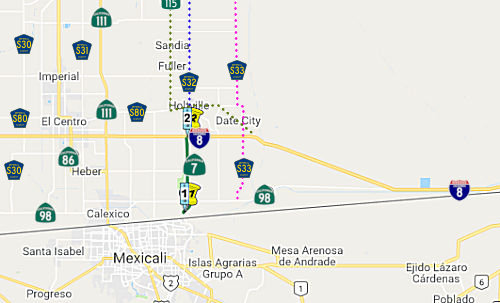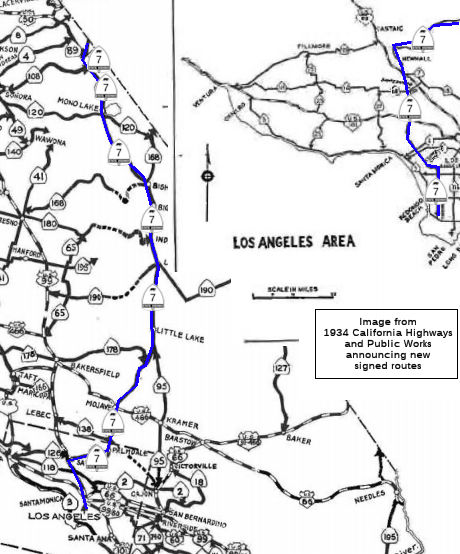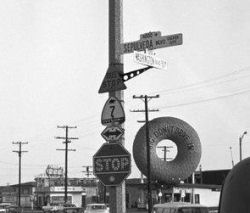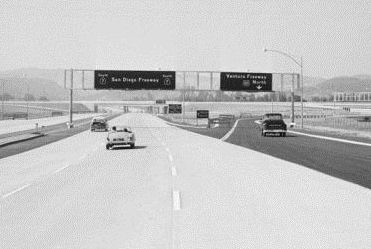

Click here for a key to the symbols used. An explanation of acronyms may be found at the bottom of the page.
 Routing
Routing From the northerly boundary of the Federal Port of Entry
near Calexico to Route 8 near El Centro.
From the northerly boundary of the Federal Port of Entry
near Calexico to Route 8 near El Centro.
 Post 1964 Signage History
Post 1964 Signage History1964-1982 Route 7 - Long Beach Freeway
 ▸ In 1963, Route 7 was defined as "from Route 11 [Present-Day
Route 110] in San Pedro to Route 210 in Pasadena via Long Beach and
including a bridge, with at least four lanes, from San Pedro at or near
Boschke Slough to Terminal Island."
▸ In 1963, Route 7 was defined as "from Route 11 [Present-Day
Route 110] in San Pedro to Route 210 in Pasadena via Long Beach and
including a bridge, with at least four lanes, from San Pedro at or near
Boschke Slough to Terminal Island."
▸ In 1965 the southern end was truncated by Chapter 1372, transferring the San Pedro portion and bridge to Route 47. This left the route definition as "from Route 1 to Route 210 in Pasadena."
▸ In 1982, Chapter 914 extended the definition to include that portion of the freeway between Route 1 and the northern end of Harbor Scenic Drive, that portion of Harbor Scenic Drive to Ocean Boulevard, that portion of Ocean Boulevard west of its intersection with Harbor Scenic Drive to its junction with Seaside Boulevard, and that portion of Seaside Boulevard from the junction with Ocean Boulevard to Route 47. It was noted that this extension didn't become operative unless the commission approves a financial plan.
In 1984, this route was transferred to Route 710 as it was approved as non-chargable interstate. See the page on I-710 for more information.
Post-1990 Route 7 at the International Border
 ▸ In 1990, the current incarnation of Route 7 was defined as
"from a new International Border crossing near Calexico to Route 8 near El
Centro." (Chapter 1187)
▸ In 1990, the current incarnation of Route 7 was defined as
"from a new International Border crossing near Calexico to Route 8 near El
Centro." (Chapter 1187)
▸ In 1994, the definition was changed to "from the northerly boundary of the Federal Port of Entry near Calexico to Route 8 near El Centro." (Chapter 1220). Note that the route appears to continue N of Route 8 as Imperial County Sign Route S32 to Route 78, although County Sign Route S32 was defined well before Route 7. Route 7 becomes Orchard Road. N of I-8.
Route 7 was added facilitate State Highway access to the new Calexico
East Port of Entry. The Calexico East Port of Entry was intended to
supplement the original Calexico Port of Entry by moving the trunk entry
east of the city. The Calexico East Port of Entry was constructed
during 1996. Route 7 was completed from the Mexican Border to Route 98 during March 1996 but did not open until December 2, 1996. The
delay in the opening of Route 7 was due to connecting highway in Mexico
not being ready.
(Source: Gribblenation Blog (Tom Fearer), "California State Route 7", 8/9/2023)
 Pre 1964 Signage History
Pre 1964 Signage History
 In 1934, Sign Route 7 was
signed along the route from Jct. Sign Route 3 (US 101A, later Route 1) at
Torrance to the California-Nevada state line north of Coleville, via
Mojave, and from the Nevada-California State Line near Reno Jct. to the
California-Oregon State Line at New Pine Creek via Alturas. Starting in
1935, the portion of this route N of former LRN 95 at the Inyo-Kern County
Line was renumbered as US 395. In that routing, it began at the Oregon
border, and consisted of the following segments:
In 1934, Sign Route 7 was
signed along the route from Jct. Sign Route 3 (US 101A, later Route 1) at
Torrance to the California-Nevada state line north of Coleville, via
Mojave, and from the Nevada-California State Line near Reno Jct. to the
California-Oregon State Line at New Pine Creek via Alturas. Starting in
1935, the portion of this route N of former LRN 95 at the Inyo-Kern County
Line was renumbered as US 395. In that routing, it began at the Oregon
border, and consisted of the following segments:
 From San Fernando to
Westchester, near the present-day Los Angeles International Airport.
This segment originally proceeded down Maclay and Brand in San Fernando
to Sepulveda Blvd. By the mid-1950s, it was running on Sepulveda Blvd
directly from the southern terminus of the "Golden State Freeway" from
approximately San Fernando Blvd (although the map I have doesn't show
Sign Route 7 running N of San Fernando, so it is possible the
routing had been truncated by then). Sign Route 7 then continued S along
Sepulveda to Pico (in the San Fernando Valley, Sepulveda Blvd was at one
time Saugus Avenue), where it jogged W to Sawtelle, and then S to
Washington (where it was under construction between Washington and
Centinela). At one time, however, it actually continued along Sepulveda.
It terminated at the interchange of Sepulveda Blvd . and Century Blvd.
US 101A ran along Lincoln, and continued under the LAX Tunnel.
From San Fernando to
Westchester, near the present-day Los Angeles International Airport.
This segment originally proceeded down Maclay and Brand in San Fernando
to Sepulveda Blvd. By the mid-1950s, it was running on Sepulveda Blvd
directly from the southern terminus of the "Golden State Freeway" from
approximately San Fernando Blvd (although the map I have doesn't show
Sign Route 7 running N of San Fernando, so it is possible the
routing had been truncated by then). Sign Route 7 then continued S along
Sepulveda to Pico (in the San Fernando Valley, Sepulveda Blvd was at one
time Saugus Avenue), where it jogged W to Sawtelle, and then S to
Washington (where it was under construction between Washington and
Centinela). At one time, however, it actually continued along Sepulveda.
It terminated at the interchange of Sepulveda Blvd . and Century Blvd.
US 101A ran along Lincoln, and continued under the LAX Tunnel.
By 1938, Sign Route 7 was constructed south of LRN 164/Centinela
Avenue to US 101A/LRN 60 near the grounds of Los Angeles Municipal
Airport. The segment of LRN 158/Sepulveda Boulevard north of LRN 164/Centinela Avenue in Culver City was unconstructed. By 1939,
the segment of Route 7/LRN 158 on Sepulveda Boulevard between Brand
Boulevard and US 99-6/LRN 4 at San Fernando Road was opened. The
segment of Sign Route 7/LRN 158 from Jefferson Boulevard south to
Route 107/LRN 164 at Centinela Avenue was not yet constructed due to
it requiring extensive drainage. By 1942, construction was
authorized for Sign Route 7/LRN 158 on Sepulveda Boulevard from
Slauson Avenue south to Sign Route 107/LRN 164 at Centinela
Avenue.
(Source: Gribblenation Blog (Tom Fearer), "California State Route 107", May 2022)
 As the San Diego Freeway was constructed, it ran along the San Diego
Freeway. Some portions in the San Fernando Valley were signed as Sign
Route 7 (as indicated in the photo), but portions in West LA were
signed as I-405 (even prior to the great renumbering). These segments
were the original segment of LRN 158 added in 1933. Sepulveda Blvd was
named for the Sepulveda family of early Los Angeles.
As the San Diego Freeway was constructed, it ran along the San Diego
Freeway. Some portions in the San Fernando Valley were signed as Sign
Route 7 (as indicated in the photo), but portions in West LA were
signed as I-405 (even prior to the great renumbering). These segments
were the original segment of LRN 158 added in 1933. Sepulveda Blvd was
named for the Sepulveda family of early Los Angeles.
Scott Parker (SParker) on AAroads noted: "The initial construction on
I-405 actually started shortly before the Interstate era as a freeway
upgrade to then Route 7 (LRN 158) between Culver City and the Santa
Monica Mountains; that segment opened to traffic at the end of 1957
with Sign Route 7 signage; that was replaced by that summer with I-405
signage." Note that this means the Route 7 signage on this section
existed for perhaps 5-6 months at best.
(Source: Scott Parker (SParker) on AAroads, "Re: I-405 widening in Orange County has started", 1/24/2019)
Interesting historical note: There was once a reservoir in Sepulveda Canyon operated by the Santa Monica Water Company. It failed in 1914.
The Sepulveda Tunnel opened on September 27, 1930. Sepulveda Pass was paved and became a state highway route in 1935. In the November 1935 issue of CHPW, there is an interesting article on the Sepulveda Tunnel construction and dedication. Although the tunnel was constructed in 1930, the state highway between Ventura and Sunset was opened and dedicated on October 20, 1935. The article noted that the first steps to a modern Sepulveda came in 1922, as the the Indian footpath was transformed into a highway of commerce. The section opened in 1935, 7.6 mi in length, was from Ventura Blvd to Sunset. It was surfaced with 30-foot asphalt concrete pavement bordered on each side by oil-treated rock shoulders, costing $300K, and financed out of the state gasoline tax. Grading was previously completed in 1930. The tunnel is 665' long, and bored through the mountains 130' under Mulholland Drive. The 1935 project involved the completion of 2.1 mi of new road, and the improvement of 3.3 mi of existing road.
Tom Fearer describes it thusly: The original Sign Route 7 was announced
as a highway originating at Sign Route 3/LRN 60 (future US 101A, later
Route 1) in Torrance northward to the Nevada State Line, which connected
through the Reno Area to a second segment to the Oregon State Line.
Sign Route 7 was originally defined followed the entirety of LRN 164 from
Sign Route 3/LRN 60 north to LRN 158. Sign Route 7 continued north
via LRN 158 to US 99/LRN 4 near San Fernando where it briefly multiplexed
it to LRN 23. Sign Route 7 followed LRN 23 along the eastern flank
of the Sierra Nevada Mountains to Topaz. From Topaz, Sign Route 7
followed LRN 95 to the Nevada State Line where a gap in the highway
existed. Sign Route 7 emerged at the California/Nevada State Line
north of Reno where it followed LRN 29, LRN 28 and LRN 73 towards the
Oregon State Line.
(Source: Gribblenation Blog (Tom Fearer), "California State Route 7", 8/9/2023)
US 395 was approved to be extended into California during 1934 by
the American Association of State Highway Officials (AASHO). US 395
would replace Sign Route 7 from near Bradys north to the Oregon State
Line. In 1937, US 6 was extended into California, and would replace Sign
Route 7 from US 395 near Bradys to US 99 near San Fernando. In 1938,
another truncation of Sign Route 7 occurred, when Sign Route 7 was
realigned to follow LRN 158/Sepulveda Boulevard south to a terminus at US 101A/LRN 158. The former routing along LRN 164 and Centinela Avenue became
Sign Route 107. In 1964, what remained of Sign Route 7 was replaced with
I-405, although signage for I-405 began in the late 1950s as the freeway
segments were constructed.
(Source: Gribblenation Blog (Tom Fearer), "California State Route 7", 8/9/2023)
1964-1982 Route 7 - Long Beach Freeway
Note that the 1964-1982 Route 7 had been signed as Sign Route 15 [LRN 167], but in 1964 the Route 15 designation was reassigned to I-15. For the history of this route, see the page for I-710 or the entry for LRN 167.
Post-1990 Route 7 at the International Border
Post-1990 Route 7 was not in the state highway system before 1990; in fact, it is new highway.
 Status
StatusA controlled access highway routing has been adopted from Route 98 (~ 007 IMP 1.164) to I-8 (~ 007 IMP 6.695), per the August 2000 CTC Agenda. It was under construction as of October 2002, according to Don Hagstrom. It was open as of March 2012, giving trucks a full expressway route to the interstate, and allowing then to avoid the narrow 2-lane Route 98. A future extension of Route 7 north may be constructed as a routing of a new Route 115 expressway as well, although this is far off.
In September 2009, the CTC relinquished right of way in the county of Imperial along Route 7 from Heber Road to Hunt Road (11-Imp-7-PM 3.7/6.3), consisting of relocated or reconstructed county roads, and frontage roads. This is likely roadway bypassed or modified by the expressway construction.
In September 2019, it was reported that there is an effort underway to
remove trucks from Orchard Road (County Sign Route S32) N of I-8. As part of this effort,
Caltrans proposes to install signage along Route 7 advising drivers of
large trucks going north to avoid Orchard Road and use alternate routes.
Route 7 becomes Orchard at Interstate 8 south of Holtville. As part of a
mid-range proposal, Caltrans is looking to develop a package of guidance
signs to provide directional information for trucks as a part of its
Traffic Investigative Report. The city of Holtville will eventually need
to cooperate with the removal of truck-route designations at Orchard and
Fourth Street, the north terminus of Orchard. Caltrans is looking at a
number of guidance signs, the first at the Commercial Vehicle Enforcement
Facility at the East Port of Entry. There would be another sign on Route 7, midway up, for further notification to truck drivers, and, just south
of I-8 on Route 7, a different sign that indicates the truck route ends in
a half mile. Wording on the signs would read, “Trucks to SR 115 use
I-8 West to SR 111 North.” This would direct trucks northbound from
Mexico to Los Angeles. Also, signs would guide trucks southbound. The
southbound sign would be at the intersection of Route 78 and Route 111 in
Brawley. The sign would read, “Trucks to Route 7 Use Route 111 South
to I-8 East.” A third sign near Holtville for trucks southbound on
Route 115 would read, “Trucks to Route 7 Use Route 115 South to I-8
West.”
(Source: Holtville Tribune, 9/12/2019)
Note: Apparently, a 2007 episode of the TV program "24" featured a Route 7 that ran from the central part of Los Angeles (Florence and something) to Newhall. Although Pre-1964 Route 7 ran to Newhall, it was only from the top of the San Fernando Valley (Sepulveda Blvd), not from Central Los Angeles.
 National Trails
National Trails
 The portions of 1934 Route 7 that correspond to US 6
and present day Route 14 were part of the Midland Trail.
The portions of 1934 Route 7 that correspond to US 6
and present day Route 14 were part of the Midland Trail.
 Freeway
Freeway[SHC 253.1] Entire route.
 Interstate Submissions
Interstate SubmissionsIn November 1957, the California Department of Highways proposed the designation I-7 for what is now I-505. This was part of an approach to number current I-5 as I-11, and use the single odd digits for what are now loop routes in the San Francisco Bay and Los Angeles areas.
 Statistics
StatisticsOverall statistics for Route 7:
 Other WWW Links
Other WWW Links1964-1982 Route 7 - Long Beach Freeway
Post-1990 Route 7 at the International Border
 Pre-1964 Legislative Route
Pre-1964 Legislative RouteThe route that would become LRN 7 was defined in the 1909 first bond act, running from Tehama Junction to Benicia.
In 1931, it was extended by the addition of the secondary routing from [LRN 14] near Crockett to American Canyon Route near Vallejo. The rationale was that the route would provide a connection from the proposed American Canyon Route to [LRN 14] near Crockett. In doing so, it would provide a complete through road for trafficc from the inland valleys to the bay area.
By 1935, the route was codified as:
It was then quickly amended by Chapter 274 to the simpler:
[LRN 14] near Crockett to Red Bluff
This amendment closed the gap between Vallejo and Red Buff, and included the [2] portion of the route that had been part of LRN 104. However, that portion was not removed until 1939.
By 1935, this was all considered a primary route. In 1957, Chapter 36 extended the route to Albany, simplifying the definition to “[LRN 69] in Albany to [LRN 3] near Red Bluff”. LRN 69 was signed as Route 17, and is approximately I-580 today. LRN 7 was signed as US 40, and is approximately I-80 today (thus, LRN 7 began near what is now the I-80/I-580 interchange). It continued NNE signed as US 40 (approximately today's I-80) until just SSW of Davis.
LRN 7 continued N cosigned as US99W/Alt US 40 until Woodland. This is present-day Route 113.
LRN 7 then jogged W briefly signed as US99W/Route 16, and then continued N signed as US99W (later the approximate routing of I-5) until the junction with US99E (LRN 3) near Red Bluff.
© 1996-2020 Daniel P. Faigin.
Maintained by: Daniel P. Faigin
<webmaster@cahighways.org>.